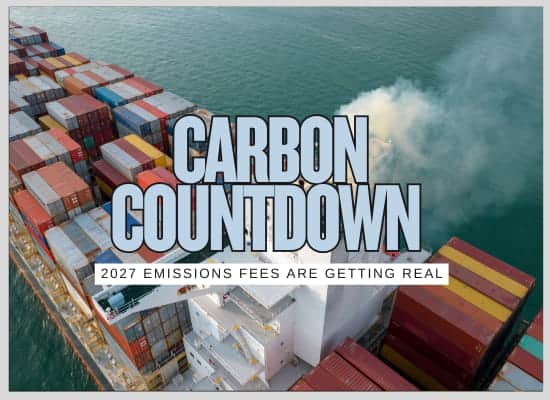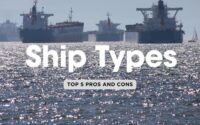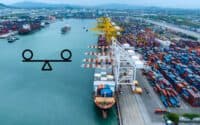IMO Carbon Tax: Where We’re Headed and What It Will Cost

In April 2025, the International Maritime Organization (IMO) approved a draft framework introducing a global carbon pricing mechanism for shipping—a significant move towards decarbonizing the maritime industry. The proposed system includes a two-tier fee structure: a base fee of $100 per ton of CO₂ emissions and a higher fee of $380 per ton for ships exceeding stricter emission thresholds. While the framework awaits formal adoption in October 2025, its implementation is slated for 2027, with actual payments beginning in 2028. This initiative positions shipping as the first industry sector with an internationally mandated carbon pricing scheme, aiming to achieve net-zero emissions by 2050.
Quick Summary
- Starts in 2027, part of the IMO’s net-zero strategy for 2050
- Ships emitting above baseline levels will pay at least $100 per ton of CO₂
- A higher tier will apply to top emitters—$380 per ton CO₂
- Revenue will support the IMO’s Net Zero Fund for clean tech and developing nations
- Policy framework is expected to be finalized by October 2025
ShipUniverse: Estimate Your 2027 IMO Carbon Tax
| Vessel Type: | |
| Fuel Type: | |
| Daily Fuel Use (tons): | |
| Voyage Days/Year: | |
| Carbon Price per Ton ($): | |
| 🌍 Estimated CO₂ Emissions & Carbon Fee will appear here | |
📉 Who’s Most at Risk?
As the 2027 IMO carbon pricing mechanism draws near, not all shipowners will feel the impact equally. While the fee applies globally, certain vessel types, operational profiles, and fuel strategies will carry a much heavier cost burden. Here's who needs to pay the closest attention:
1️⃣ Older Vessels with Poor CII Ratings
Ships built before modern fuel-efficiency standards often consume 20–40% more fuel per mile than newer designs. Combined with lower Carbon Intensity Indicator (CII) ratings, these vessels are not only more polluting but may also face:
- Higher per-day carbon fees
- Limited charter options due to CII restrictions
- Lower resale value as buyers seek compliance-ready fleets
For many operators, the carbon tax could tip the scale toward early retirement or costly retrofitting.
2️⃣ Companies with Long-Haul, Fuel-Heavy Routes
Deep-sea trades—especially Asia–Europe, transpacific, and South America–China lanes—rack up thousands of fuel-hungry nautical miles. These routes:
- Require more bunker fuel per voyage
- Generate higher total CO₂ emissions per year
- Lead to millions in added tax liability, especially for container ships, bulkers, and tankers running 200+ days per year
These operators will likely face the most dramatic annual carbon fee exposure unless they transition to cleaner fuel mixes or optimize routing.
3️⃣ Operators Still Using HFO Without Scrubbers
High-sulfur fuel oil (HFO) is among the most carbon-intensive fuels still in use. Operators who haven’t installed scrubbers or upgraded to cleaner fuel alternatives will:
- Emit over 3.1 tons of CO₂ per ton of fuel
- Pay more per nautical mile compared to ships using LNG, methanol, or even MGO
- Face increasing charter reluctance from carbon-sensitive clients and shippers
In many cases, the cost of carbon fees over 3–5 years may exceed the cost of switching fuels or investing in efficiency retrofits.
🔍 What’s Still Unknown
Despite strong momentum behind the IMO’s carbon pricing framework, several key elements remain unresolved—and they could significantly affect how shipowners plan, budget, and operate. Until these pieces are finalized, many companies are preparing with broad scenarios and flexible strategies.
1️⃣ Exact Vessel Thresholds
While the policy is expected to apply to ships over 5,000 gross tons—similar to the EU ETS—the IMO has not yet published official vessel class thresholds or exemption criteria.
What’s unclear:
- Will smaller vessels (e.g. short-sea, feeders, offshore service) be exempt?
- Will certain trades or ship types (like fishing or military support) receive carve-outs?
2️⃣ Enforcement and Verification Mechanisms
The IMO has proposed a global compliance and reporting system, but the exact enforcement details are still being debated.
What’s unclear:
- Will flag states or port states be responsible for fee collection?
- How will emissions be verified—automated reporting, audits, or physical inspections?
- What penalties will apply for non-compliance?
Many operators are watching to see if enforcement mirrors the MRV (Monitoring, Reporting, Verification) structure used in the EU.
3️⃣ Overlap with Regional Schemes (EU ETS, etc.)
The IMO’s global carbon fee may overlap or conflict with regional regulations like the EU Emissions Trading System (ETS), which already includes shipping as of 2024.
What’s unclear:
- Will ships trading into the EU pay both the IMO fee and ETS credits?
- Will there be harmonization, credit offsets, or double-charging?
- How will other regions (e.g. China, US, Japan) respond?
For global operators, this uncertainty complicates long-term financial modeling and carbon credit planning.
4️⃣ Discounts, Exemptions, or Phased Rollouts
Many developing countries and small island states have pushed for flexibility to avoid harming trade and development.
What’s unclear:
- Will there be temporary discounts or delays for vessels under certain flags?
- Will green vessels or early adopters get rebates or credits?
- Will the carbon fee start at a lower rate and phase upward, or will it launch at full strength?
Depending on how these factors play out, some operators may face minimal impact at first, while others absorb major costs from day one.
The IMO’s carbon pricing framework marks a turning point for maritime shipping. While the exact contours of the policy are still taking shape, one thing is certain: carbon will soon carry a cost, and those costs will directly impact the bottom line.
This isn’t just an environmental policy—it’s a financial planning challenge and a strategic opportunity. Shipowners who understand their emissions profile, plan for fuel transitions, and adjust charter terms proactively will be in a far better position than those who wait for the rules to land.
Whether you run a single vessel or manage an international fleet, now is the time to:
- Track fuel and emissions in detail
- Model your exposure under multiple fee levels
- Explore fuel alternatives and retrofit options
- Get ahead of contract and compliance language

Do you have a Maritime Product or Service that may be of interest to Shipowners? Tell us about it here!
Do you have feedback or insights? Please reach out to editor @ shipuniverse.com



